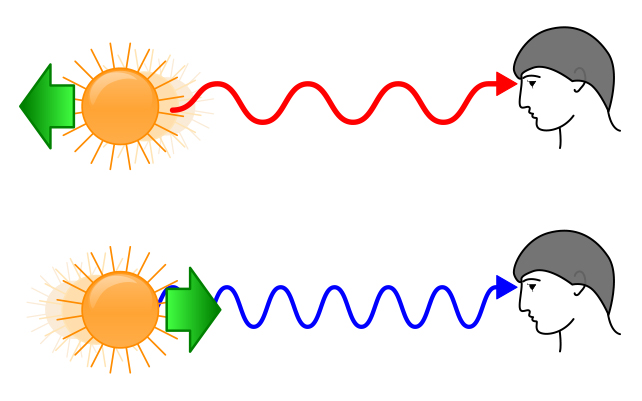Redshift describes the apparent change in the color of light emitted by an object as it moves away from an observer.
To understand why it occurs, it helps to think about a similar phenomenon many of us might experience in our day-to-day lives.
Imagine standing still on the side of the road, an ambulance drawing near with its siren blaring. Not only does the sound's volume change as it approaches, but as it zooms past the siren's tone drops, becoming a fraction deeper in pitch.
Referred to as a Doppler shift or Doppler effect, it's caused by a difference in the frequency of waves we receive from a source that either approaches or retreats.
As the ambulance's distance towards us reduces, we receive the next pressure wave a little sooner, making the sound seem more frequent than it really is. As it moves away, the distance between each wave stretches out, making them seem less frequent and therefore lower in pitch.
It's not just sound waves that experience a Doppler effect. All waves can appear to change in frequency as the distance between us and the wave's source increases or decreases.
Why is it called a redshift then?
A change in light's 'pitch' will alter its color according to its place in the electromagnetic spectrum. For instance, if the wavelength of light becomes stretched, the frequency of the waves drops, making them appear redder and creating what astronomers call a redshift. Making them a higher frequency turns the light bluer, creating a blueshift.

Most objects moving around us on Earth are too slow for us to notice shifts in their color. But far off, fast-moving objects like stars and galaxies move on scales that make the color change a lot easier to detect.
What's the difference between a stationary red star and a redshifted star?
Just like the flame of a candle isn't the same color as the flame on a gas stove, a star's color is closely related to its temperature and make-up. Astronomers can usually work out how hot a star should be according to its mass and luminosity, which gives one good starting point on what color it should be.
Far more important is the specific rainbow of colors (or its spectrum) emitted as a result of the materials floating about in the star's gasses.
The electrons of different compounds and elements absorb light waves of very specific frequencies. This well-defined 'fingerprint' means we know exactly what spectral lines should appear for just about every known chemical.
Spread starlight out into a rainbow of colors, you'll see a barcode-like pattern of shadows appear caused by the way its mix of materials absorbs light. While different stars might have different spectral lines, the patterns act like notes in a song. The song stays familiar, even if it's sung at a higher or lower pitch.
To astrophysicists, a redshifted object is the cosmic equivalent of a squeaky-sounding verse of 'Twinkle Twinkle Little Star', making it clear it's not meant to be as red as it seems.
Why is redshift useful in astronomy?
Redshift tells us two things in astronomy.
The first is that no matter where we look into the far, far distance, objects are moving away from us at great speed.
This means either everything is being pushed away from Earth (and we're standing still), or everything is being pushed apart from everything else. Given an important principle that says we shouldn't think of ourselves as anything special, cosmologists assume the very fabric of the Universe must be expanding.
The second thing redshift can tell us is the distance between us and an object.
Not only do objects in the distance appear to be moving away from us, they seem to do so at a faster rate than those closer. This higher velocity means its 'song' of spectral lines will seem even more distorted the further away it is.
Astronomers can use a formula to provide a shift in the wavelength based on the pattern of spectral lines, which provides a measure called 'z'.
Depending on other assumptions, such as whether space curves slightly on huge scales, z translates into a specific distance, such as parsecs or light-years.
All Explainers are determined by fact checkers to be correct and relevant at the time of publishing. Text and images may be altered, removed, or added to as an editorial decision to keep information current.
